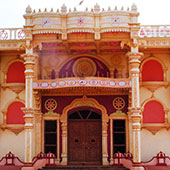Design Resource
Bidar Fort - Karnataka
An Ancient Bahmani Monument
by
Prof. Bibhudutta Baraland Srikanth B.
Bidar is a city in the Indian State of Karnataka, named after Bamboo, locally called “Bidiru”. The origin of its name traces back to an old bamboo jungle that lasted in the area. This city at the edge of Deccan Plateau is from the northeastern part of the state, hence called the peak of Karnataka. Bidar city is regarded for its ancient forts and handicraft products. The city, the district, and the fort are all tagged with the name Bidar.
The Bidar Fort built in 1426-32 AD by Bahmani King Sultan Ahmad Shah, is considered the most difficult trek in the country. The fort is surrounded by a rare to find triple moat, introduced by Turkish Mercenaries. Other notable structures include its seven well-protected gateways, two main gates to the palace complex, and several elegant monuments within it. The Sharza Darwaza and the Gumbad Darwaza, are the massive complex gates that open to the southern side, enhanced with domes, arches and paintings. The passage area between these gateways possesses the capacity to accommodate three thousand soldiers on duty to shield the fort. Mandu Darwaza is another brilliantly designed gate that opens to a well-defended underground tunnel, protected by 37 bastions, huge cannons, and large weapon magazines. Other architecturally diverse and outstanding monuments within the fort are Takht Mahal, Turkish Mahal, Rangeen Mahal, Gagan Mahal, Shahi Matbakh (Royal Kitchen), Diwani-i-Am (Public Audience Hall), Solah Khamba Mosque and the Naubat Khana.
Gagan Mahal:
The Gagan Mahal, meaning heavenly palace was built in the 14-15th century AD. Though its construction was initiated during the Bahmani rule, the following Baridi Shah rulers made certain alterations and additions to the building plan. Their modifications were mainly targeted towards the northern side of the palace and the apartments on the upper southern wing, leaving the rest as it is from the Bahmani dynasty. Architecturally, the rooms on the ground floor were allotted to the staff and guards while upstairs for royal ladies. Here the Sultan was found to reside in the inner court of the main building.
Turkish Mahal:
Built-in 1432, the Turkish Mahal is an epitome of Indo Islamic craftsmanship. It is believed that the palace was exclusively built for Turkish wives of the Sultan. The Mahal houses a special room with granite and floral decorations solely built for royal guests and other important members of the sultanate. The building provides a wonderful view of the Bidar fort from its terrace. But now, it is badly affected with time, hence has collapsed hugely.
Diwan-i-Am and Diwan-i-Khas:
Diwani-I-Am was a magnificent court built for public discussions. It carries intricate frameworks and detailing giving it the name of Jali Mahal. While Diwan-I-Khas is a fort that stands tall near the Solah Khamba Mosque. It is regarded for its high-walled magnificent audience hall.
The Madrasa:
The Madrasa known as Islamic school was built by Khwaja Mahmud Gawan, a Persian scholar and Prime Minister to the court of Mohamad Shah. The structure completed in Persian Architectural Style is a work of architects and engineers invited all the way from Persia and other Middle-Eastern countries. The Madrasa is a three-storied building with towering minarets. The minarets are part of the quadrangle plan, where the first and second floors are projected around balconies without bracket support. Here the fascia is adorned with colored Chevron tile with parapets done in a cusped pattern, which is a unique style of Persian art. The bulbous domes are, however, in the Timurid style. In 1696, the Madrasa was damaged by lightning as it housed cavalry barracks and powder magazines intensifying the damage. Even now, in the ruined state, the Madrasa is an impressive construction.
































